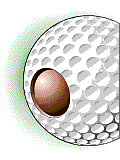
http://sportsillustrated.cnn.com
Many people would argue that the
ball is the single most important part of the game of golf. It's design
and make-up determine its behavior in all phases of the game. The golf
ball has evolved much over the years. Physics is largely responsible for
this evolution, and the very existence of the golf ball as we know it today.
Have you ever wandered why there are dimples on golf balls? It turns out that they have dimples for more than cosmetic purposes. The original golf balls were actually made out of smooth horsehide. Golfers discovered that the balls that were scarred up seemed to travel further, so they preferred using the old balls to new ones. Eventually golf balls were made with the dimples to simulate the scarring of the old balls. While early golfers may not have realized it, their observation can be proven legitimate by using principles of physics. The scars, or now dimples, actually create turbulence as the air passes over the ball. This in effect reduces the drag on the ball, allowing it to travel further. Amazingly a dimpled ball will travel about twice as far as a smooth ball!
Have you ever wandered why there are dimples on golf balls? It turns out that they have dimples for more than cosmetic purposes. The original golf balls were actually made out of smooth horsehide. Golfers discovered that the balls that were scarred up seemed to travel further, so they preferred using the old balls to new ones. Eventually golf balls were made with the dimples to simulate the scarring of the old balls. While early golfers may not have realized it, their observation can be proven legitimate by using principles of physics. The scars, or now dimples, actually create turbulence as the air passes over the ball. This in effect reduces the drag on the ball, allowing it to travel further. Amazingly a dimpled ball will travel about twice as far as a smooth ball!
The materials used to make golf balls are also
very important to their performance. The early golf balls were stuffed
with feathers. Today golf balls have cores that are made of the same type
of rubber that can be found in vehicle tires. They are covered with a hard
rubbery substance called balata. As one might now guess, physics plays a
role in this as well. The harder cores of today's golf balls allow them
to travel further because they do not deform as much when the club comes
into contact with the ball.
Main Page
Physics of clubs
Tee-ing Off
In-Flight
The Short Game
Bibliography